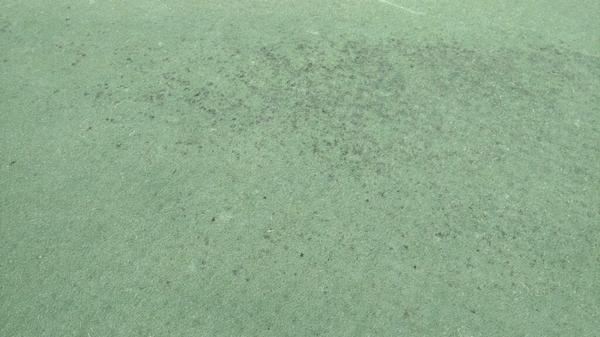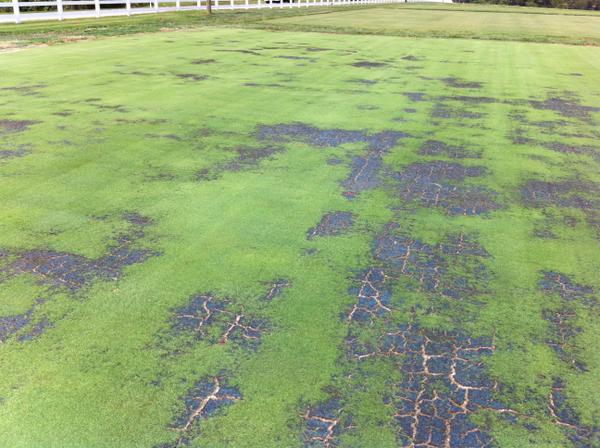Symptoms
Although they do not infect grasses, blue-green algae are a significant pest problem in the turfgrass industry. These organisms contain chlorophyll just like plants, but they grow by producing chains of thread-like cells similar to fungi. Symptoms of algae appear in areas where the turf canopy has been thinned by poor growing conditions or other pest activity. In these areas, a green or black mat of fuzzy growth is evident in the turf canopy or on the surface of the thatch. During dry weather, this algal growth forms a dry, cracking crust on the thatch surface that repels water and impedes turf recovery.
Development Factors
Algae may develop whenever thinning of the turf canopy permits sufficient air, light, and water to reach the thatch surface. Algal growth is most aggressive during the late spring, summer, and early fall when warm, humid conditions are conducive to algae growth and turf thinning. Low mowing heights, shady conditions, poor soil drainage, and frequent irrigation encourage algal growth in the turf canopy. Repeat applications of plant growth regulators and/or DMI fungicides may cause thinning of the turf canopy in close-cut turf such as a golf course putting green, leading to algae invasion.
Algae have historically been considered secondary colonizers, meaning they only fill areas where some other problem has reduced turf density. However, mounting evidence indicates that high levels of algae activity can directly cause thinning of putting green turf, possibly by production of toxins or competition for air, water, and nutrients. An aggressive algae management program can significantly increase the density and overall quality of putting greens during warm and humid weather.
Cultural Control
Maintenance of dense, healthy turf is the most effective way to prevent algae invasions. Avoid establishing turf in heavily shaded or poorly drained areas, or take steps to correct these problems in established turf. Mow at the recommended height for each turfgrass species and increase mowing heights in shady areas to compensate for the reduced light levels. Irrigation should be applied deeply and infrequently; apply sufficient water to wet the entire root zone, and then reapply as needed when the turf shows signs of wilt. Putting greens and other high traffic areas must be cultivated regularly to maintain soil drainage and aeration.
Chemical Control
Ammonium sulfate, hydrated lime, or other materials can be applied to “burn” the algae in infested areas. Extreme caution is needed when doing this, especially on golf course putting greens, as these materials can also burn the turf or cause nutritional imbalances in the soil.
The fungicides chlorothalonil and mancozeb are effective algaecides. These products will control algae on a preventative or curative basis, but preventative applications are much more effective. Repeat applications on a 10 to 14 day interval during warm, humid weather provides excellent algae control and significantly increases the density of putting green turfgrasses. Note that chlorothalonil and mancozeb are not approved for application to residential lawns.
Fungicides containing copper hydroxide should be used with caution, as copper can accumulate in the soil to toxic levels after repeated applications. For this reason, copper hydroxide should only be used under extreme circumstances to bring severe algae infestations under control.
Once a severe algae infestation has occurred, fungicide applications alone will not provide acceptable control. Additional steps must be taken to physically break-up the mat of algal growth so that the turf can recover. Spiking, aerification, verticutting, topdressing, or combinations thereof are effective ways to accomplish this.
* Products marked with an asterisk are not labeled for home lawn use.
| Fungicide and Formulation1 | Amount of Formulation2 | Application Interval (Days)3 | Efficacy Rating | Resistance Risk | FRAC Code4 |
|
boscalid + chlorothalonil (Encartis)* |
3 to 4 | 14 | ++++ | Low | 7/M5 |
| chlorothalonil (Daconil Ultrex)* |
1.8 to 5 |
7 to 14 |
++++ | Low | M5 |
| chlorothalonil (Daconil Weather Stik)* | 2 to 3.6 4 to 5.5 |
7 to 14 14 |
++++ | Low | M5 |
| chlorothalonil (Daconil Zn)* | 3 to 5 6 to 8 |
7 to 14 14 |
++++ | Low | M5 |
| chlorothalonil + acibenzolar-s-methyl (Daconil Action)* |
2 to 3.6 4 to 5.4 |
7 to 14 14 |
++++ | Low | M5/P01 |
| chlorothalonil + azoxystrobin (Renown)* | 2.5 to 4.5 | 10 to 14 | ++++ | Low | M5/11 |
| chlorothalonil + fluoxastrobin (Fame C)* | 3 to 5.4 | 7 to 14 | ++++ | Low | M5/11 |
| chlorothalonil + thiophanate-methyl (Spectro)* | 2 to 3.72 | 7 | ++++ | Low | M5/1 |
| fluazinam (Secure)* | 0.5 | 14 | ++ | Low | 29 |
| fluazinam + acibenzolar-S-methyl (Secure Action)* | 0.5 | 14 | ++ | Low | 29/P01 |
| fluazinam + tebuconazole (Traction)* | 1.3 | 14 | ++ | Low | 29/3 |
| fluxapyroxad (Xzemplar) | 0.21 to 0.26 | 14 to 28 | + | Low | 7 |
| mancozeb (Fore)* | 6 | 10 to 14 | ++ | Low | M3 |
|
1 Other trade names with the same active ingredients are labeled for use on turfgrasses and can be used according to label directions. |
|||||
| Efficacy Rating ++++ = excellent control when conditions are highly favorable for disease development +++ = good control when disease pressure is high, excellent control when disease pressure is moderate ++ = good control when disease pressure is moderate, excellent control when disease pressure is low + = good control when disease pressure is low ? = not rated due to insufficient data |
|||||
| Resistance Risk Low = Rotate to different chemical class after 3-4 applications; tank mixing not necessary Medium = Rotate to different chemical class after 1-2 applications; tank-mixing with low or medium risk product recommended High = Rotate to different chemical class after EVERY application; tank-mix with low or medium risk product for EVERY application ? = not rated due to insufficient data |
|||||
Publication date: Nov. 9, 2017
Reviewed/Revised: Aug. 19, 2022
Recommendations for the use of agricultural chemicals are included in this publication as a convenience to the reader. The use of brand names and any mention or listing of commercial products or services in this publication does not imply endorsement by NC State University or N.C. A&T State University nor discrimination against similar products or services not mentioned. Individuals who use agricultural chemicals are responsible for ensuring that the intended use complies with current regulations and conforms to the product label. Be sure to obtain current information about usage regulations and examine a current product label before applying any chemical. For assistance, contact your local N.C. Cooperative Extension county center.
N.C. Cooperative Extension prohibits discrimination and harassment regardless of age, color, disability, family and marital status, gender identity, national origin, political beliefs, race, religion, sex (including pregnancy), sexual orientation and veteran status.





